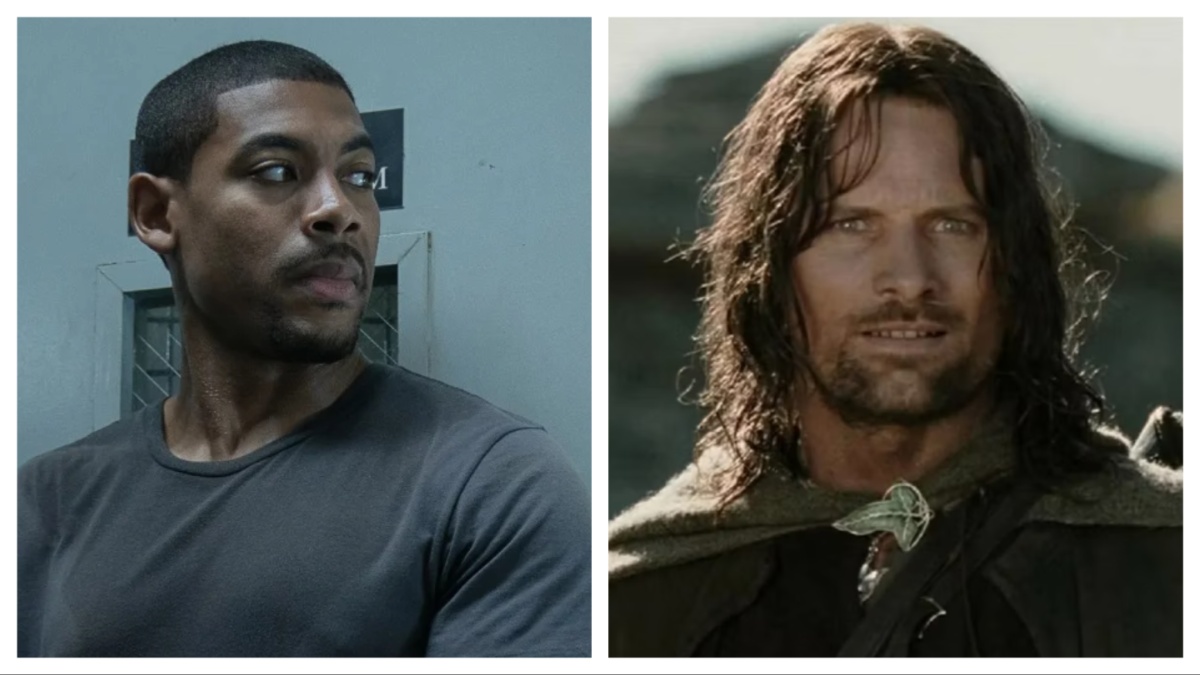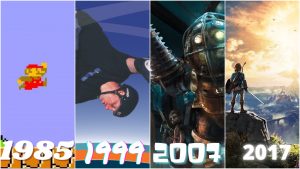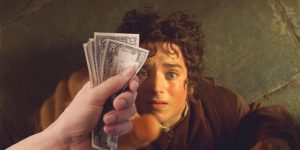
Sometimes stars are “born” in the gauzy Hollywood daydream of the word, with a big-time producer or director played by Warner Baxter grabbing you by the shoulders and promising, “You’re going out there a youngster but coming back a star!” Sometimes though—more often, in fact—it isn’t nearly so glamorous. Sometimes you’ve got to audition, scrape, claw… and still not get the part.
… But then fate steps in! And whoever was offered the role over you, or whoever was cast before you, ends up dropping out at the last minute. In those instances, it would seem that providence itself lends a hand. These are the stars that were born of fire and tribulation.
Aaron Pierre in Rebel Ridge
Let’s begin with the breakthrough of the moment, whose big turn came from the unlikely province of a Netflix original film. Quietly dropped on the streaming service earlier this month, Jeremy Saulnier’s Rebel Ridge turned out to be a cut above typical streaming fare, which perhaps shouldn’t be so surprising given this is also the writer-director of Green Room. What is a real revelation, though, is Aaron Pierre, the six-foot and three-inch mountain of charisma who elevates the character of Terry Richmond into a modern day desperado and high parish drifter.
In a role reminiscent of the best “loner fixes corrupt town” setups synonymous with Spaghetti Westerns, Pierre disarms, dismantles, and then unmans an entire nest of corrupt coppers in modern-day Louisiana, all while never losing that Cheshire grin. It’s an impressive feat since he didn’t join the production until after the film paused production for months.
Indeed, the role of Terry Richmond was originally supposed to be played by John Boyega, who not only signed on for the film but was in the midst of shooting it when he left the production under reportedly contentious circumstances. Whatever the reason, the film had been shooting for nearly a month when he dropped out, and Pierre didn’t come aboard until almost half a year after that (production itself was paused a full 10 months). Nonetheless, according to most viewers today, the troubles became became a boon for the streaming sensation.
Viggo Mortensen in The Lord of the Rings
Perhaps the most famous instance of an actor being replaced mid-production—or at least right before principal photography—is Stuart Townsend losing out on the role of Aragorn in Peter Jackson’s Lord of the Rings trilogy despite having spent months rehearsing for the part. While reports differ whether he was let go either the day before cameras rolled, or rather the first or second day after he began filming, the fact remains that Jackson and his producers came to the conclusion well into the eleventh hour that they wanted somebody else.
Jackson has spoken repeatedly about deciding the then 28-year-old Townsend was too young for the man who would be King of Gondor, and looked for an older actor who would have some gray in his beard (Viggo Mortensen was 42 at the time he was cast). Other specifics remain difficult to parse out, but Townsend opened up about the disappointment in 2019, saying, “I have no good feelings for those people in charge, I really don’t. The director wanted me and then apparently thought better of it because he really wanted someone 20 years older than me and completely different.”
Mortensen of course became an international star after playing Aragorn in all three Lord of the Rings movies, which he parlayed into a career largely defined by indie films with choice auteurs like David Cronenberg—as well as Green Book.
Hugh Jackman in X-Men
Another icon of 2000s action and nerd cinema is Hugh Jackman in his signature role: the Wolverine. Not only is it a character that defined Hugh Jackman’s big break in Hollywood but also his whole career, with Jackman showing an enduring affection for Logan by returning to the part time and again for the last 24 years.
Yet he was the very definition of a last-minute stand-in since the part of Wolverine was originally offered to and accepted by Scottish actor Dougray Scott. Considered an up-and-comer at the time, Scott had also been cast in the role of the big bad for Mission: Impossible II, which came out the same summer as 2000’s X-Men. While reports vary as to why exactly he was unable to wrap up production on time on M:I2 and get to Canada to shoot X-Men (the most common reason given is that production went over-schedule on the John Woo spy movie), the producers and director Bryan Singer were left scrambling to find a replacement.
Australian Jackman, meanwhile, was a virtual unknown in Hollywood and had only recently found success in London in a stage revival of Oklahoma! The actor still reveals nuggets of the casting process, too, such as auditioning on the set of X-Men during Singer’s lunch break. Recently talking to the New York Times, he said, “I was flying up to do a [screen] test with the director, and it was lunch hour. The director was like, ‘I don’t understand what’s going on, I’ve got Dougray Scott playing the part. Why am I auditioning another guy?’ I’ve never known more that I’m not getting a part.”
Of course he did ultimately get the gig, and it would pave the way to a major Hollywood career that spans from action movie spectacles like the X-Men films and Van Helsing to musical epics (Les Misérables, The Greatest Showman) and auteur-driven dramas (Prisoners, The Prestige, The Fountain). Not to mention a pretty spectacular Broadway stage career too.
Michael J. Fox in Back to the Future
Michael J. Fox was already a star of sorts when he got Back to the Future, but only insofar as he was popular on the small screen for a supporting role on the sitcom Family Ties. But that small bit of celebrity is also why despite being the first choice to play Marty McFly for director Robert Zemeckis and writer/producer Bob Gale, Fox initially couldn’t take the role—he was too busy with the TV schedule. His TV producers wouldn’t even let him see the movie’s script.
So Zemeckis and Universal cast up-and-coming dramatic actor Eric Stoltz as Marty. They even spent weeks on set filming with him… before coming to the conclusion it just wasn’t working. The reasons, again, are somewhat hazy, but it is widely agreed on that as a method actor, Stoltz brought an intensity and seriousness to the role that did not complement the comedic screwball nature of the material.
“Eric is such a different actor and he could be very difficult,” co-star Lea Thompson said in 2015. “It was a time when we were emerging from the ‘70s. All the young actors wanted to be like De Niro and Pacino, which was good in a lot of ways. Now a lot of young actors are just like businessmen. It was a different time. But it was not the right movie to behave like that.”
Zemeckis ultimately went to the head of Universal and asked permission to fire Stoltz and to pursue Fox. He was granted it, but they had to continue filming Stoltz for multiple days, all while he was unaware he was already terminated, until they had the replacement cast. Fox jumped at the part, even as it required working on Family Ties during the day, and shooting Back to the Future at night and on breaks. It proved a shrewd hardship since the role made Fox one of the biggest stars of his generation.
Humphrey Bogart in The Maltese Falcon and High Sierra
For moviegoers of a certain age, Humphrey Bogart was the absolute epitome of cool. His haggard but wise face, his high-collared trench coat, those well-worn and world-weary fedoras and cigarettes. He cut an image entirely different of the movie stars who came before and after—which includes George Raft, whose infamous pickiness set up Bogie’s unlikely middle-age ascendency.
Little remembered today, Raft was one of the bigger stars on the Warner Bros. Pictures’ lot in the 1930s, appearing in many of their “tough guy” movies where Bogie was just one of many supporting players, often as a heel. But by 1941, Raft had a habit of saying no to a lot of projects, including early landmark film noirs High Sierra and The Maltese Falcon. Raft was supposed to play the lead in both, including the iconic Dashiell Hammett sleuth, Sam Spade, in The Maltese Falcon. Yet in the fast turnaround of Golden Age Hollywood, he shot both roles down consecutively, the latter because he didn’t want to be directed by a first-time helmer like John Huston (before this, Huston was only a lowly scribe).
That served Huston fine. He cast his real-life drinking buddy Bogart in the role of Spade. In many ways, it defined our idea of the film noir detective and his hardboiled style and cadence. It also put Bogart on the path to all-time classics like Casablanca, The Big Sleep, The Treasure of Sierra Madre, Key Largo, and The African Queen, the latter two of which were also written and directed by Huston.
Samuel L. Jackson in Pulp Fiction
Quentin Tarantino wrote the part of Jules Winnfield in Pulp Fiction for Laurence Fishburne. So much so that he offered the part to Fishburne and his team as soon as the screenplay was finished. Unfortunately, his team told him to pass.
Looking back on the experience it in The Rewatchables podcast, Tarantino said, “They suggested that he pass… And the reason they suggested is because they said, ‘Here’s the deal. You could have done this last year, but the reason you hired us is to make you a leading man, to make you a star… If this was your Class Action time, you could have done it, but you can’t do that anymore. Now it’s gotta be Larry Fishburne in [movie], with name above the title.’”
According to QT, Fishburne was told you need to say ‘no’ to supporting roles, no matter how good they are if you want to be a leading man. In theory this is sound advice, however Fishburne ended up starring in Bad Company. Meanwhile relative unknown character actor Samuel L. Jackson took the role of Jules and not only received a Best Supporting Oscar nomination but developed a screen presence that has made him one of the most popular actors in the world, with both leading and supporting roles.
Harrison Ford in Raiders of the Lost Ark
We admit this last one is a bit of a cheat. After all, Harrison Ford already starred in one of the most popular movies of all-time by the time Raiders of the Lost Ark came along. And yet, we must point out that as beloved and talented as Mark Hamill and Carrie Fisher were even then, consider where their careers as actors went after Star Wars. Being the lead of a cultural event film like that does not guarantee sustained or true movie stardom, or even an escape from typecasting.
So enters Harrison Ford’s relationship with Indiana Jones, a role he was not the first choice to be cast in. In fact, when Steven Spielberg first floated the idea of ol’ Harry Ford as Dr. Jones, it was George Lucas who axed it, saying he didn’t want Ford to “become my De Niro,” in reference to how often contemporary director Martin Scorsese used Robert De Niro as his leading man. So Spielberg and Lucas wound up casting Tom Selleck in the role of Indiana.
At the time, Selleck had already filmed the pilot for Magnum P.I. over at CBS and was obligated in his contract to do the show if it was ordered to full-series. Nonetheless, he was cast as Indy and Paramount asked for Selleck to be released from his contract. Instead, the TV network recognized the actor was in demand and ordered a full season of Magnum, forcing Selleck to do the show over the film. When he dropped out, Raiders of the Lost Ark was mere weeks away from production.
Hence a quick call to Ford. Also while Ford was, again, a well-known actor, he was at the time doing smaller roles like a supporting part to Gene Wilder in The Frisco Kid and a cameo in Apocalypse Now. Suddenly, he was in a role that harkened back to some of that Bogie swagger. Afterward, he would almost always be the lead and in big studio projects he could handpick—movies like Witness, Blade Runner, and Working Girl.
The post Last Minute Actor Replacements Who Became Movie Stars appeared first on Den of Geek.






